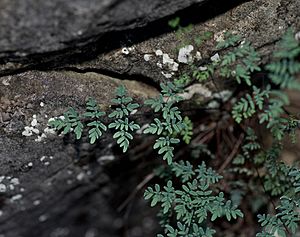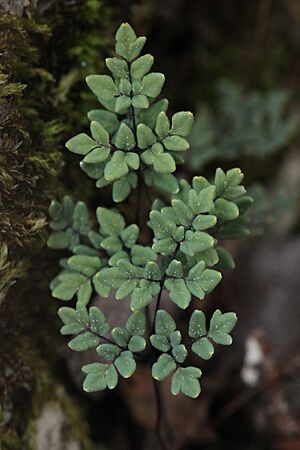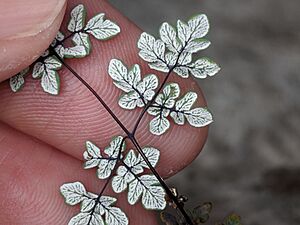Powdery false cloak fern facts for kids
Quick facts for kids Powdery false cloak fern |
|
|---|---|
 |
|
| The powdery false cloak fern growing in a rock crevice. | |
| Conservation status | |
| Scientific classification | |
| Genus: |
Argyrochosma
|
| Species: |
dealbata
|
The Argyrochosma dealbata, also known as the powdery false cloak fern, is a small fern found only in the central and southern United States. It likes to grow on rocks that contain calcium carbonate, like limestone.
This fern has leaves that are divided into many small parts. These leaf parts are connected by shiny, reddish-brown stems. The cool thing is, the underside of its leaves is covered with a white powder. This powder is what gives the fern its name! Scientists first described this fern in 1814. Later, in 1987, it was moved into a new group of ferns called Argyrochosma, which means "false cloak ferns." This was done because they are different from other ferns known as "cloak ferns."
Contents
What Does the Powdery False Cloak Fern Look Like?
The powdery false cloak fern grows from a short, upright stem called a rhizome. This rhizome usually doesn't branch out. It has brown or yellowish-brown scales that are about 3 millimeters (0.1 inches) long. These scales are thin and have smooth edges.
The fern's leaves, called fronds, grow in groups from the rhizome. They can be from 3 to 15 centimeters (1.2 to 5.9 inches) long. The leaf stalk, called the stipe, is shiny and can be pale brown, reddish-brown, or chestnut brown. It's about 2 to 7 centimeters (0.8 to 2.8 inches) long. The shiny brown color of the stalk continues into the main stem of the leaf and its branches.
Leaf Shape and Texture
The leaf blades are shaped like a triangle or a spearhead, widest at the bottom. They are divided many times, sometimes up to five times! The blades are 2 to 6 centimeters (0.8 to 2.4 inches) long and 1.5 to 6 centimeters (0.6 to 2.4 inches) wide. They have 3 to 5 pairs of main leaf branches, called pinnae.
The final small parts of the leaf are oval-shaped. The leaf tissue itself is a bluish-green color and feels somewhat leafy. You can often see the veins on the top surface of the leaf.
The Powdery Underside
The most special feature of this fern is the white (or sometimes yellowish) powder that covers the underside of its leaves. This powder is called farina. The top surface of the leaf is usually smooth and doesn't have any powder or hairs.
The edges of the leaf segments curl back. This helps to protect the sori, which are small clusters of spore-producing structures called sporangia. These sporangia contain 64 spores, which are released in the summer and fall.
How Scientists Named This Fern
Like many ferns, the powdery false cloak fern has had several different scientific names over time.
Early Discoveries
The first person to describe this fern was Frederick Traugott Pursh in 1814. He named it Cheilanthes dealbata. He found it growing along the Missouri River. The name dealbata means "covered in white powder," which perfectly describes the fern's leaves.
Later, in 1843, another scientist named Gustav Kunze also described the fern, but he didn't know Pursh had already done it. He called it Notholaena pulchella. He found his specimen in Missouri. Kunze noticed that his fern was smaller and had more divisions than a similar fern, and he also pointed out the white powder. The name pulchella means "small and beautiful." Kunze later realized it was the same fern Pursh had described and changed its name to Notholaena dealbata in 1848.
Changing Names Over Time
Over the years, scientists found it hard to group ferns correctly. So, this fern was moved to different groups by different scientists:
- In 1852, Antoine Laurent Apollinaire Fée moved it to Cincinalis.
- In 1859, Georg Heinrich Mettenius tried to move it to Gymnogramma, but that name was already used for a different fern, so it wasn't valid.
- In 1882, Karl Anton Eugen Prantl moved it to Pellaea.
- In 1883, George Edward Davenport thought it was just a variety of another fern, Notholaena nivea.
Its Current Name
By the late 1900s, scientists still debated where this fern belonged. In 1987, Michael D. Windham studied these ferns closely. He created a new group called Argyrochosma and moved this fern into it, giving it its current name, A. dealbata.
In 2018, another scientist, Maarten J. M. Christenhusz, tried to move it to Hemionitis, naming it H. artax. However, the name dealbata was already taken in that group. The name artax comes from the horse of Atreyu in the book The Neverending Story.
Scientists have learned that A. dealbata is closely related to A. limitanea, another fern found in the southwestern United States and northern Mexico. These two ferns are like sisters in the plant world.
The name "false cloak ferns" for Argyrochosma comes from their similarity to "cloak ferns" (Notholaena). Cloak ferns get their name because their leaf edges curl back, like a cloak, covering their spores.
Where Does the Powdery False Cloak Fern Live?
The powdery false cloak fern is found only in the United States. You can find it from western Illinois, south and west through Arkansas and Missouri, to southeastern Nebraska. It also grows south through Kansas and Oklahoma to Texas. There's even a separate group of them in south-central Kentucky.
This fern loves to grow in cracks and ledges of cliffs or rocks that are rich in calcium carbonate, like limestone.
Protecting This Fern
The powdery false cloak fern is generally considered "apparently secure" (G4) by the NatureServe conservation status system. This means it's not in immediate danger of disappearing.
However, in some states like Arkansas and Oklahoma, it's considered "imperiled," meaning it's at risk. The fern is no longer found in Nebraska, and the one known location in Kentucky is now considered historical.
Growing the Powdery False Cloak Fern
Some people have tried to grow this fern. Gustav Kunze, one of the early scientists, thought it would be good for growing. He noted it was grown in Berlin in sunny greenhouses.
It's been suggested that this fern prefers medium light and soil that is relatively dry and drains well. It might also like sandy soil with a high pH level.




